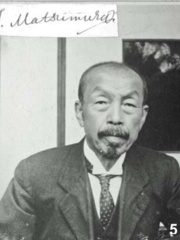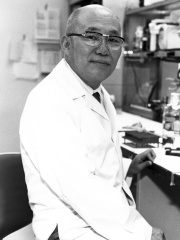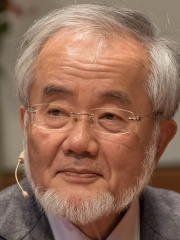
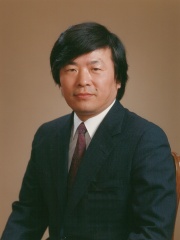
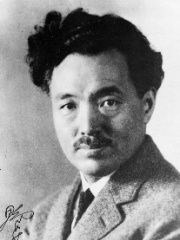
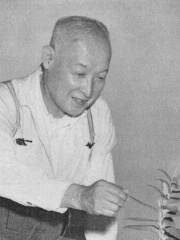
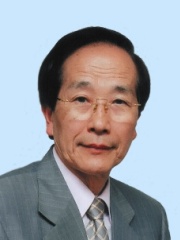
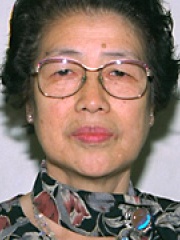
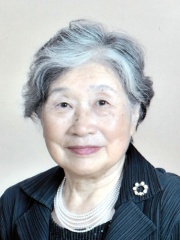
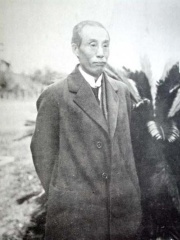
The Most Famous
BIOLOGISTS from Japan
This page contains a list of the greatest Japanese Biologists. The pantheon dataset contains 1,097 Biologists, 15 of which were born in Japan. This makes Japan the birth place of the 13th most number of Biologists behind Netherlands, and Czechia.
Top 10
The following people are considered by Pantheon to be the top 10 most legendary Japanese Biologists of all time. This list of famous Japanese Biologists is sorted by HPI (Historical Popularity Index), a metric that aggregates information on a biography's online popularity. Visit the rankings page to view the entire list of Japanese Biologists.

1. Yoshinori Ohsumi (b. 1945)
With an HPI of 76.17, Yoshinori Ohsumi is the most famous Japanese Biologist. His biography has been translated into 69 different languages on wikipedia.
Yoshinori Ohsumi (大隅 良典, Ōsumi Yoshinori; born February 9, 1945) is a Japanese cell biologist specializing in autophagy, the process that cells use to destroy and recycle cellular components. Ohsumi is a professor at Institute of Science Tokyo's Institute of Innovative Research. He received the Kyoto Prize for Basic Sciences in 2012, the 2016 Nobel Prize in Physiology or Medicine, and the 2017 Breakthrough Prize in Life Sciences for his discoveries of mechanisms for autophagy.

2. Susumu Tonegawa (b. 1939)
With an HPI of 68.32, Susumu Tonegawa is the 2nd most famous Japanese Biologist. His biography has been translated into 57 different languages.
Susumu Tonegawa (利根川 進, Tonegawa Susumu; born September 5, 1939) is a Japanese scientist who was the sole recipient of the Nobel Prize for Physiology or Medicine in 1987 for his discovery of V(D)J recombination, the genetic mechanism which produces antibody diversity. Although he won the Nobel Prize for his work in immunology, Tonegawa is a molecular biologist by training and he again changed fields following his Nobel Prize win; he now studies neuroscience, examining the molecular, cellular and neuronal basis of memory formation and retrieval.

3. Hideyo Noguchi (1876 - 1928)
With an HPI of 64.20, Hideyo Noguchi is the 3rd most famous Japanese Biologist. His biography has been translated into 37 different languages.
Hideyo Noguchi (野口 英世, Noguchi Hideyo; November 9, 1876 – May 21, 1928), also known as Seisaku Noguchi (野口 清作, Noguchi Seisaku), was a Japanese bacteriologist at the Rockefeller Institute during its foundation under Simon Flexner and known for his work on syphilis and contributing to the long term understanding of neurosyphilis. During the emergence of the field of serology, he began as a research assistant to American physician Silas Weir Mitchell in his studies on snake venom at the University of Pennsylvania in 1901. Mitchell and Noguchi presented the results before National Academy of Science. Noguchi was an early advocate of the widespread use of antivenoms before their mass production in the United States. In 1903, Noguchi went to the Statens Serum Institute in Denmark and produced one of the first antiserums to treat the North American rattlesnake bite alongside Thorvald Madsen. In 1909, he wrote his comprehensive monograph, Snake Venoms: An Investigation of Venomous Snakes with Special Reference to the Phenomena of Their Venoms, which contained several drawings and photographs of specimens. Beginning his career at the Rockefeller Institute during its foundation, Noguchi was the first person in the United States to confirm the causative agent of syphilis, Treponema pallidum, after it was first identified by Fritz Schaudinn and Erich Hoffmann in 1905. His most notable achievement was isolating Treponema pallidum in the brain tissues of patients with general paresis and tabes dorsals, a late stage consequence of tertiary syphilis. His discovery established the conclusive link between the physical and mental manifestation of syphilis. American educator and psychiatrist John Clare Whitehorn considered it an outstanding psychiatric achievement. Later in his career, Noguchi developed the first serum to give partial immunity to Rocky mountain spotted fever, a notoriously lethal disease before treatment was discovered. He also suggested the name for the genus Leptospira in 1917. However, he became increasingly erratic and inaccurate, which might have been exacerbated from contracting syphilis, progressing to neurosyphilis, discovered during his autopsy by William Alexander Young combined with his poor education from childhood. He misidentified yellow fever as being caused by the bacteria, Leptospira icterohemorrhagiae, and received scrutiny when it was later understood to be a virus with the invention of a electron microscope. Prior to this scrutiny, Noguchi died of the disease in Accra, Gold Coast during an expedition to Africa in search for its cause. Posthumously, his work on yellow fever was overturned alongside his claims of discovering the causative agent of rabies, poliomyelitis, trachoma and his culture of syphilis could not be reproduced. His research with his colleague Evelyn Tilden after his death proved that Carrions disease and verruca peruana were the same species. Noguchi was one of the first Japanese scientists to gain international acclaim outside of Japan for his scientific contributions. In addition, he was nominated several times for a Nobel prize in medicine between 1913 and 1927, often bringing more attention to neglected tropical diseases. His name is attached to the spirochete, Leptospira noguchii. In 2004, Noguchi's face was featured on the 1000 yen note. The Hideyo Noguchi Africa prize is given in his honor.

4. Takenoshin Nakai (1882 - 1952)
With an HPI of 63.75, Takenoshin Nakai is the 4th most famous Japanese Biologist. His biography has been translated into 24 different languages.
Takenoshin Nakai (中井 猛之進, Nakai Takenoshin; November 27, 1882, Gifu Prefecture – December 6, 1952) was a Japanese botanist. In 1919 and 1930, he published papers on the plants of Japan and Korea, including the genus Cephalotaxus. Between 1943 and 1945, during the Japanese occupation of the Dutch East Indies (now Indonesia), Takenoshin Nakai was the director of 's Lands Plantentuin in Batavia (now Bogor Botanical Gardens in Bogor).
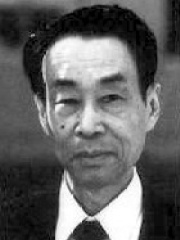
5. Motoo Kimura (1924 - 1994)
With an HPI of 63.56, Motoo Kimura is the 5th most famous Japanese Biologist. His biography has been translated into 25 different languages.
Motoo Kimura (木村 資生, Kimura Motō) (November 13, 1924 – November 13, 1994) was a Japanese biologist best known for introducing the neutral theory of molecular evolution in 1968. He became one of the most influential theoretical population geneticists. He is remembered in genetics for his innovative use of diffusion equations to calculate the probability of fixation of beneficial, deleterious, or neutral alleles. Combining theoretical population genetics with molecular evolution data, he also developed the neutral theory of molecular evolution in which genetic drift is the main force changing allele frequencies. James F. Crow, himself a renowned population geneticist, considered Kimura to be one of the two greatest evolutionary geneticists, along with Gustave Malécot, after the great trio of the modern synthesis, Ronald Fisher, J. B. S. Haldane, and Sewall Wright.

6. Akira Endo (1933 - 2024)
With an HPI of 60.66, Akira Endo is the 6th most famous Japanese Biologist. His biography has been translated into 21 different languages.
Akira Endo (遠藤 章, Endō Akira; 14 November 1933 – 5 June 2024) was a Japanese biochemist whose research into the relationship between fungi and cholesterol biosynthesis led to the development of statin drugs, which are some of the best-selling pharmaceuticals in history. Endo received the Japan Prize in 2006, the Lasker-DeBakey Clinical Medical Research Award in 2008, the Canada Gairdner International Award in 2017.

7. Katsuko Saruhashi (1920 - 2007)
With an HPI of 59.62, Katsuko Saruhashi is the 7th most famous Japanese Biologist. Her biography has been translated into 27 different languages.
Katsuko Saruhashi (猿橋 勝子, Saruhashi Katsuko; March 22, 1920 – September 29, 2007) was a Japanese geochemist who created tools that let her take some of the first measurements of carbon dioxide (CO2) levels in seawater. She later showed evidence of the dangers of radioactive fallout and how far it can travel. Along with this focus on safety, she also researched peaceful uses of nuclear power. Her other major area of significance involved raising the number and status of women scientists, especially in Japan. She established both the Society of Japanese Women Scientists and the Saruhashi Prize, which is awarded annually to a female scientist who serves as a role model for younger women scientists. Among her other honors, she was the first woman elected to the Science Council of Japan, to earn a doctorate in chemistry from the prestigious University of Tokyo, and to win the Miyake Prize for Geochemistry.

8. Tsuneko Okazaki (b. 1933)
With an HPI of 58.96, Tsuneko Okazaki is the 8th most famous Japanese Biologist. Her biography has been translated into 23 different languages.
Tsuneko Okazaki (岡崎 恒子, Okazaki Tsuneko; born June 7, 1933) is a Japanese pioneer of molecular biology known for her work on DNA replication and specifically for discovering Okazaki fragments, along with her late husband Reiji. Dr. Tsuneko Okazaki has continued to be involved in academia, contributing to more advancements in DNA research.

9. Bunzō Hayata (1874 - 1934)
With an HPI of 57.38, Bunzō Hayata is the 9th most famous Japanese Biologist. His biography has been translated into 16 different languages.
Bunzō Hayata (早田 文藏, Hayata Bunzō; December 2, 1874 – January 13, 1934) was a Japanese botanist noted for his taxonomic work in Japan and Japanese Taiwan.
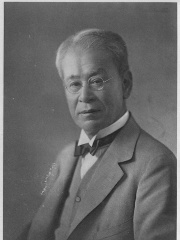
10. Tomitaro Makino (1862 - 1957)
With an HPI of 57.08, Tomitaro Makino is the 10th most famous Japanese Biologist. His biography has been translated into 20 different languages.
Tomitaro Makino (牧野 富太郎, Makino Tomitarō; 24 April 1862 – 18 January 1957) was a pioneer Japanese botanist noted for his taxonomic work. He has been called "Father of Japanese Botany", having been one of the first Japanese botanists to work extensively on classifying Japanese plants using the system developed by Linnaeus. His research resulted in collecting more than 500,000 specimens, many of which are represented in his Makino's Illustrated Flora of Japan. Despite having dropped out of grammar school, he eventually attained a Doctor of Science degree, and his birthday is remembered as Botany Day in Japan.
People
Pantheon has 15 people classified as Japanese biologists born between 1856 and 1959. Of these 15, 4 (26.67%) of them are still alive today. The most famous living Japanese biologists include Yoshinori Ohsumi, Susumu Tonegawa, and Tsuneko Okazaki. The most famous deceased Japanese biologists include Hideyo Noguchi, Takenoshin Nakai, and Motoo Kimura.
Living Japanese Biologists
Go to all RankingsYoshinori Ohsumi
1945 - Present
HPI: 76.17
Susumu Tonegawa
1939 - Present
HPI: 68.32
Tsuneko Okazaki
1933 - Present
HPI: 58.96
Ryuta Kawashima
1959 - Present
HPI: 52.90
Deceased Japanese Biologists
Go to all RankingsHideyo Noguchi
1876 - 1928
HPI: 64.20
Takenoshin Nakai
1882 - 1952
HPI: 63.75
Motoo Kimura
1924 - 1994
HPI: 63.56
Akira Endo
1933 - 2024
HPI: 60.66
Katsuko Saruhashi
1920 - 2007
HPI: 59.62
Bunzō Hayata
1874 - 1934
HPI: 57.38
Tomitaro Makino
1862 - 1957
HPI: 57.08
Akira Miyawaki
1928 - 2021
HPI: 56.39
Tokiharu Abe
1911 - 1996
HPI: 55.48
Jinzō Matsumura
1856 - 1928
HPI: 54.20
Yasutomi Nishizuka
1932 - 2004
HPI: 53.78
Overlapping Lives
Which Biologists were alive at the same time? This visualization shows the lifespans of the 4 most globally memorable Biologists since 1700.




